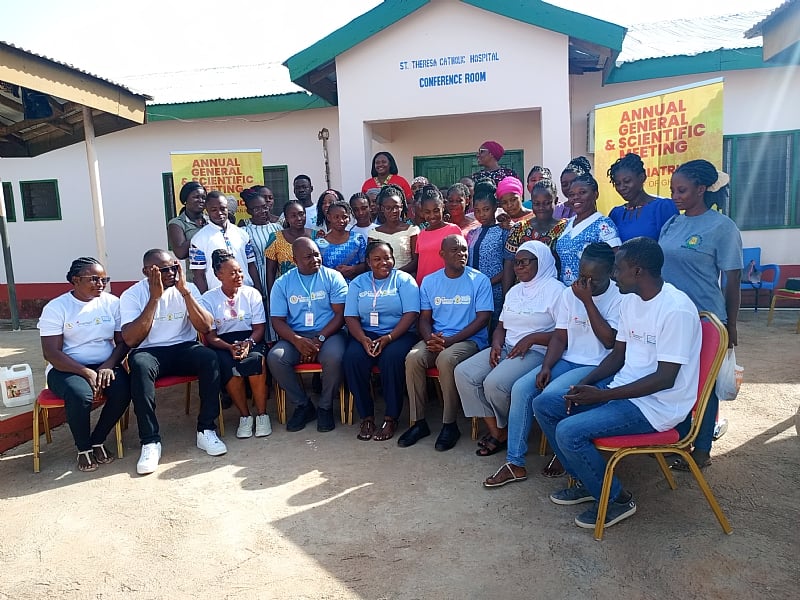In a determined effort to reduce maternal and newborn mortality, St. Theresa’s Hospital in Nandom has begun the implementation of a lifesaving project designed to equip frontline health workers with the skills to respond effectively to childbirth and neonatal emergencies.
The initiative, titled “Mastering Maternal and Newborn Emergencies,” was conceived by Dr. Haruna Mahama, a paediatrician at the hospital, who responded to the urgent need for emergency care in underserved communities.
Dr. Mahama submitted the proposal to Grand Challenges Canada, which accepted and is funding the pilot project.
This week, the hospital hosted a five-day intensive training session for selected health workers from the Nandom Municipality only. The training focused on managing maternal and newborn emergencies and introduced innovative approaches to care delivery. Similar training sessions will be held in the other selected districts in due course.
Facilitating the training is Dr. Samuel Salamat, a paediatrician from the Komfo Anokye Teaching Hospital in Kumasi, who is currently stationed at St. Theresa’s Hospital for the program.
Dr. Salamat described the training as timely and crucial, emphasizing its goal of building the capacity of health professionals to respond promptly and competently to emergency situations.
He explained that the project has two main components. The first is in-service training aimed at equipping doctors, nurses, and midwives with critical hands-on skills for managing maternal and neonatal emergencies. These include how to help babies breathe when born without signs of life, how to manage postpartum complications, and how to detect early warning signs in both mothers and newborns.
The second component aligns with the Ghana Health Service’s network of practice model, which envisions district hospitals serving as referral hubs, with CHPS Compounds and other peripheral health facilities acting as spokes. Under this arrangement, lower-level facilities refer complicated cases upwards for more specialized care, creating a coordinated and efficient system of emergency response.
A notable innovation in the project is the digital monitoring system recently installed at St. Theresa’s Hospital. A large screen now enables staff to track labor cases in real time from facilities within the network. This allows doctors to intervene swiftly, offer guidance remotely, and prevent unnecessary delays in handling critical cases.
Dr. Sebastian Ninimiya Yidana, the Medical Superintendent of St. Theresa’s Hospital and an experienced Obstetrician Gynaecologist, is leading the training on the ground. He underscored the urgent need for such capacity-building efforts, especially in rural areas where health workers often manage complex emergencies with limited resources.
“We often encounter cases where mothers or babies arrive in a critical condition. If the attending health worker lacks the skills to respond immediately, the outcome can be fatal. This training is designed to bridge that gap,” he said.
He added that the training is hands-on and highly practical. Participants have gone through step-by-step simulations on how to help babies breathe when they are born and are not breathing or crying. They were also trained in essential newborn care, infection prevention and control, and effective referral procedures.
The project is being piloted in eight districts—five in the Upper West Region and three in the Upper East Region.
In the Upper West, the selected districts include Nandom Municipal, Jirapa Municipal, Nadowli District, Sissala East District, and Wa Municipal. Each district will organize its own training session involving 36 selected health professionals and a designated health facility acting as a coordinating hub.
Some of the participants in the Nandom session shared their experiences and impressions.
“This training has come at the right time to boost our performance,” said Naa-ifaa Ernestina, a midwife at the Nandom Health Center. “Three of us from our facility took part, and we’ll pass on the knowledge to our colleagues.”
Ullo Flavia, a midwife from Piiri Health Center, added: “We’ve learned so much from this. If it’s maintained and expanded, it will boost our confidence and improve service delivery in hard-to-reach areas.”
Dr. Yidana expressed hope that the successful implementation of the Nandom pilot will lay the foundation for wider adoption across the country.
“This is a local initiative with national relevance. If it proves successful, it will show that practical, community-based training supported by the right tools can save lives across Ghana,” he said.
The work being done at St. Theresa’s Hospital highlights the power of innovation, collaboration, and local leadership in transforming maternal and newborn healthcare in even the most remote parts of Ghana.


